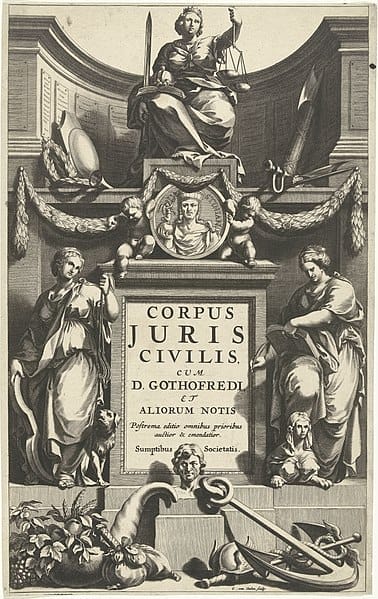Roman Law was a complex system that permeated every aspect of ancient Roman life, and its approach to sexual offenses is a topic of both historical and legal significance. Within this intricate legal framework, sexual offenses were defined and dealt with in ways that reflected the prevailing social norms and gender roles of the time.

Sexual crimes under Roman Law encompassed a range of acts from adultery to offenses against slaves, with penalties varying according to the status of those involved. Legal authorities, such as the censors, played a significant role in maintaining moral order through their power to punish transgressions. The legal texts of the Republican and Imperial periods provide insights into the evolution of laws pertaining to sexual misconduct, as well as into the broader societal values that these laws were designed to protect.
Key Takeaways
- Sexual offenses in Roman Law reflected the social values and hierarchical structures of ancient Rome.
- Penalties for sexual crimes varied significantly, often depending on the individuals’ social status.
- The Roman legal system’s treatment of sexual offenses offers insights into the civilization’s broader social and cultural norms.
Historical Background of Roman Law
The legal system of Ancient Rome laid the groundwork for Western jurisprudence. It evolved over centuries, adapting to societal changes and the needs of complex governance. During the Republican Period, the Twelve Tables were inscribed, becoming the earliest codification of Roman law and signaling a shift toward a more systemic legal order.
As Rome transitioned into the Imperial Period, law expanded further, driven by the emperors and jurists who shaped legal practices. The law was no longer exclusively within the elite’s purview but became a more inclusive tool for societal governance. The Digest, an expansive compilation of juristic writings, along with the Codex, a collection of statutes and principles, and the Institutes, a legal textbook, formed a comprehensive code known as the Corpus Juris Civilis.
This monumental work, commissioned by Emperor Justinian in the 6th century, sought to consolidate and revise centuries of legal thought and practice. Roman law has influenced countless legal systems worldwide, with its concepts serving as a foundation for modern law codes. The process and structure of Roman law remain a powerful testament to the civilization’s profound impact on legal history.
Sources and Development of Roman Law
The foundation of Roman law is a complex tapestry woven from a variety of sources, including written statutes, legal precedents, and scholarly interpretations. Over time, it borrowed elements from Greek philosophy, demonstrating a rich interplay between emergent legal concepts and prevailing societal norms.

Written and Unwritten Law
Roman law was initially derived from both written statutes and customary practices. The Twelve Tables, inscribed around 450 BCE, served as one of the earliest codifications of Roman laws.
This distinction between codified laws and customs or mos maiorum was critical as it provided a framework for Roman legal principles and the rights of citizens. Over time, new statutes and praetorian edicts were introduced, contributing further to the legal corpus.
Legal Texts and Jurisprudence
Legal texts drafted by scholars played an integral role in shaping Roman legal practices. Key among these authors were Gaius and Ulpian, whose writings provided a systematic approach to understanding and applying the law.
Gaius’s Institutes is a seminal piece of legal literature that detailed procedures, while Paulus, another influential jurist, contributed significantly to the development of legal theories. Their writings were used to instruct and guide future generations of Roman jurists.
Influences of Greek Philosophy
The adaptation of Greek philosophy into Roman law can be seen through the work of eminent legal thinkers who sought to reflect the ethical standards of their time. Philosophical schools like Stoicism influenced Roman legal thought, emphasizing virtues such as justice and natural law. This intellectual exchange broadened the scope of Roman legal principles, incorporating a philosophical dimension into the predominantly pragmatic Roman legal system.
Legal Institutions and Authorities
Within the framework of Roman law, legal institutions and authorities were central to the prosecution and adjudication of sexual offenses. The system was characterized by distinct roles and functions distributed among various officials and entities, from magistrates to the emperor himself. These organs not only enforced laws but also adapted them to the changing social fabric of Roman society.

Magistrates and Assemblies
Magistrates in ancient Rome, particularly consuls and praetors, held significant judicial powers and presided over courts. They were responsible for the administration of justice, including hearing cases related to sexual offenses.
The assemblies, including the Comitia Centuriata and Comitia Tributa, played a crucial role by participating in legislative processes and, at times, acting as a court of appeals through the mechanism of provocatio—an appeal to the Roman citizens against the decisions of a magistrate.
The Role of the Emperor
The Emperor of Rome was the ultimate authority, exerting profound influence over the law. Although Roman law was not designed in the sense of a modern law code, the emperor’s declarations and edicts could transform legal practice and policy. Particularly from the Principate onwards, the emperor could intervene directly in legal matters, which included issuing decisions on cases of sexual offenses.
Praetors and Their Edicts
Praetors, especially the Urban Praetor, were instrumental in both civil and criminal law. They issued edicts – a form of temporary legislation – which substantially shaped the legal landscape.
These edicts would often be compiled and serve as guidelines for judges dealing with various matters, including sexual offenses. The Praetors’ role was so influential that their compiled edicts, the Edictum Perpetuum, became a cornerstone of Roman legal practice.
The Justice System and Legal Procedure
In ancient Rome, the legal procedures and intricacies of the justice system played a critical role in maintaining social order and addressing crimes. The distinctions between trial processes and the types of law applied are essential for understanding how justice was administered.
Trials and Appeals
Trials in the Roman legal system followed a formal process, often beginning with the accusatio, an initiation of proceedings by a complainant. Cases went through a preliminary hearing (in iure) before a magistrate, who would determine if there was sufficient cause to proceed.
If the case was admitted, it moved to the iudicium, where it was heard and decided by a judge or a panel of judges. The ability to appeal a decision was limited, but higher magistrates could review some cases.
Public versus Private Law
Roman law was divided into two overarching categories: public law (ius publicum) and private law (ius privatum). Public law governed relations between the state and individuals. It was seen as the domain of the communities as a whole, addressing crimes and other matters that affected the public interest. Conversely, private law is related to matters between individual citizens, such as property disputes and contracts.
Criminal Law and Civil Law
Key distinctions existed between criminal law and civil law in the context of Roman society. Criminal law dealt with offenses that threatened public order and welfare, with penalties often including fines, public service, or harsher methods like exile or capital punishment for more severe cases.
Civil law, however, resolved issues between private individuals, where remedies typically involved compensatory measures rather than punitive ones. Roman criminal proceedings also evolved over time, transitioning from the legis actio procedure to the more in-depth cognitio trial system.

Citizenship and Legal Status
In ancient Rome, an individual’s legal rights and protections under the law were significantly influenced by their citizenship status. Roman law delineated clear differences in the legal capacities between citizens, foreigners, and slaves, particularly regarding sexual offenses.
Roman Citizens and the Empire
Roman citizens enjoyed a range of privileges and protections under the law that were not available to non-citizens. For instance, a Roman citizen had the right to a fair trial and could not be subjected to torture or corporal punishment in the same way as slaves or non-citizens could.
When it came to sexual offenses, laws existed to protect the virtue of Roman women of citizen status, although such protections were often contingent on their social standing and marital status. For instance, the rape of a freeborn Roman woman was a punishable offense. However, the legal concept of stuprum, rooted in the protection of family honor rather than individual consent, underscored these laws.
Status of Foreigners and Slaves
Foreigners (peregrini) and slaves were not granted the same legal considerations as citizens within the Roman legal system. Foreigners had some legal rights, but they lacked the full protection available to Roman citizens, especially in regard to personal violations such as sexual assaults. The position of the peregrini improved with the Constitutio Antoniniana in 212 A.D., extending citizenship to many freeborn inhabitants of the empire.
Slaves were considered property under Roman law and, as such, had no legal autonomy or protection from sexual abuse by their masters. The law did not recognize sexual offenses against slaves unless they infringed upon the property rights of their owners – hence, one could be liable for the stuprum of another’s slave as it would be considered property damage.
Family Law and Personal Status
Roman law intricately tied family law and personal status, which directly influenced an individual’s rights and responsibilities within society. These legal aspects governed the intricate family dynamics, the status of women, and the patriarchal structure prevalent in Roman society.
Marriage Laws
Marriage in Roman times was seen not just as a personal union but as a legal state affecting property and citizenry. The conubium was a right that allowed two Roman citizens to marry, providing the legal capacity to generate legitimate offspring and share property.
Sine manu, a form of marriage, allowed women to remain under their father’s authority instead of transferring to their husband’s (manus), contrasting with the earlier cum manu marriage that fully transferred control over the woman to the husband.
Patria Potestas and Inheritance
In Roman law, patria potestas refers to the autocratic power of the father or family patriarch over the family. This legal authority included control over property and the legal capacities of children within the family unit. It even granted the paterfamilias the right to arrange or dissolve marriages or hold sway over inheritance matters. Inheritance was closely linked to family structure and personal status. Sons were typically primary heirs, while daughters’ inheritance depended on their marital status and the existence of brothers.
Property and Obligations

Within the framework of Roman law, two of the fundamental aspects were the handling of property, including its ownership and associated rights, and the management of obligations, which encompassed contractual agreements and delicts. These components formed the core of private law, effectively framing the legal relationships between individuals, particularly in terms of restitution and compensation for wrongs involving property.
Ownership and Property Rights
The concept of ownership in Roman law was comprehensive, extending to real property (land and buildings) and personal property (movable items and slaves). The owners enjoyed extensive rights over their property, with the capacity to use, enjoy, and dispose of it as they saw fit.
Noteworthy is the Lex Aquilia, Rome’s principal legislative act concerning torts, which played a crucial role in formulating the principle of wrongful damages to property. This law particularly addressed the wrongful killing of a slave or livestock, establishing a framework that quantified compensation based on the highest value of the property within the previous year.
Contractual Obligations and Delicts
Contractual obligations in Roman law were established through various means, including verbal contracts, written agreements, and actions symbolizing consent. These contracts were binding and enforceable, with the law providing remedies if one party failed to honor their obligations. In line with this, delicts were considered wrongful acts that breached a duty, leading to an obligation to compensate the victim.
The Lex Aquilia once again comes into prominence by extending its purview to damages caused by actions other than wrongful killings. Under this law, causing harm to another’s property by means other than theft, typically through negligence or recklessness, imposed obligations on the perpetrator to provide financial restitution.
Criminal Offenses and Legal Penalties

In ancient Rome, the legal system articulated a variety of offenses and corresponding penalties, focusing on the protection of the person, morality, and property. The severity of the punishment often reflected the social status of the persons involved and the nature of the crime.
Crimes Against the Person
Homicide: It was a grave offense with penalties depending on the victim’s status. Legally, killing a free person could lead to capital punishment or exile.
Assault: Physical attacks varied in their severity, with penalties ranging from fines to corporal punishment.
Castration: This act, often seen as an attempt to damage another’s lineage, could incur severe repercussions, potentially even death.
Rape: The Roman concept of rape (stuprum) typically dealt with assault against a citizen. While not closely akin to modern interpretations, the repercussions could be severe if social boundaries were crossed. For more information on the concept and legal view on sexual offenses in Roman times, refer to Stuprum: public attitudes and penalties for sexual offences in Republican Rome.
Crimes Against Morality
Stuprum: Beyond the physical act, it included a broader category of sexual crimes, which could tarnish a family’s honor, leading to societal shame and legal penalties.
Adultery: Treated as a crime against morality and family, adulterers could face penalties including banishment, fines, or, in extreme cases, death.
Crimes Against Property
Theft and property damage could lead to various levels of penalties, from financial reparations to physical punishment. The significance of the penalty was often proportional to the value of the property and status of the individuals involved.
Parricide: Killing a close relative, especially a parent, was an especially heinous crime in Rome, viewed as an act against both family and the state. Accused parricides could face the death penalty, oftentimes by a method designed to reflect the gravity of their crime. Criminal proceedings in these cases were exhaustive, reflecting the seriousness with which such offenses were regarded.
Special Legal Topics
In ancient Roman law, the treatment of sexual offenses was deeply intertwined with social structures and cultural norms, including religion and societal statuses. The legal approach to these crimes highlighted the disparities between different classes and genders within Roman society.
Religion and Magic in Law
Religious beliefs played a fundamental role in ancient Roman law, often merging with legal principles, particularly in managing societal conduct. For instance, aspects of sexual offenses were often perceived and adjudicated through the lens of religious and magical practices.
The state religion, which was an essential part of public and private life, had specific sexual morality requirements, and deviation from these could be deemed a transgression against both the gods and societal norms. Magic, on the other hand, was generally frowned upon, and laws were in place to sanction those who used enchantments to manipulate or harm others sexually.
Class and Gender Considerations
Within the stratified structure of Roman society, the upper classes wielded significant influence on the formation and enforcement of laws. This influence extended to the realm of sexual offenses, with often harsher penalties prescribed for crimes involving members of the elite. Masculinity was a highly valued trait, and laws sometimes reflected the importance of preserving the dignity of freeborn males, particularly those of high status.
By contrast, women, especially from lower classes, had limited legal agency and protections, highlighting the pervasive inequalities of the time. Laws governing sexual offenses were often less about protection and more about preserving family honor and property rights.
Impact and Legacy of Roman Law
Roman Law has profoundly influenced the legal systems of many countries, particularly in Continental Europe. Its principles are enshrined in the foundational texts that have shaped modern jurisprudence.

Continental Legal Systems
Roman law’s codification, most notably in Justinian’s Corpus Juris Civilis, laid the groundwork for the civil law systems prevalent across Continental Europe. This legal tradition is characterized by comprehensive legal codes that aim to cover all areas of law and its application. For instance, Napoleon’s Civil Code in France drew heavily upon Roman law principles and has, in turn, influenced the civil law systems in countries such as Italy, Spain, and Germany.
Roman Law in Modern Jurisprudence
The legacy of Roman law extends beyond Continental Europe and can be observed in legal scholarship and education across the world. Many legal terms and concepts commonly used today, such as stare decisis and culpa in contrahendo, have their origins in Roman law.
The Byzantine Empire carried the torch of Roman legal principles after the fall of the Western Roman Empire, keeping the tradition alive until it could be rediscovered in the West. The jus gentium, or “law of nations,” developed by Rome, has influenced international law with its treatment of foreigners and citizens under a common legal framework. Roman legal thought contributes to the way modern legal systems consider everything from property rights to contract law.
Cultural and Societal Influences
Roman law regarding sexual offenses was deeply intertwined with the cultural and societal norms of the time. Influences from literature and art were particularly significant in shaping the perceptions and legal structures of sexual behavior in Roman society.
Literature and Art
In Roman culture, literature and art were not merely forms of entertainment but also important sources of moral and social guidance. Literary works of the period, such as Ovid’s “Ars Amatoria,” both reflected and shaped the societal attitudes toward sexual conduct. These creative expressions offered insight into the mos maiorum, or the “ways of the ancestors,” which were the foundational customs and traditions upheld in Roman society.
The narratives within these cultural artifacts often conveyed the virtues of chastity, marital fidelity, and proper behavior—parallel to the legal expectations of the time. Art, including vases, sculptures, and frescoes, depicted mythological and everyday scenes that provided a visual counterpart to the narrative literature. They portrayed not only the idealized forms of behavior but also the consequences of sexual impropriety, serving as cautionary tales. Such representations could be said to have served an educative purpose.
Both Greek and Roman narratives contributed to this cultural landscape, with the legacy of Greek philosophy and mythology exerting significant influence over the Roman intellectual environment. Architecture, such as temple decor and public building reliefs, often reinforced the same themes of sexual mores and legal consequences found in literature and art.

People Also Ask:
This section provides clear and concise answers to some of the most commonly inquired aspects of Roman Law as it pertains to sexual offenses.
What legal consequences did adultery incur in ancient Roman society?
In ancient Roman society, adultery was considered a serious offense with grave consequences.
The Lex Julia de adulteriis, implemented by Augustus, prescribed that the adulterers could be exiled or their property could be confiscated as a penalty.
How did ancient Roman laws address sexual assault?
Ancient Roman laws addressed sexual assault with considerable severity.
The Lex Iulia de vi publica et privata was a law that explicitly penalized sexual violence and assault, marking these actions as punishable by the state.
What were the legal implications for homosexuality in Roman times?
Homosexuality, per se, did not have legal consequences in Roman times, as personal sexual behaviors were not typically subject to legislation.
However, behaviors that transgressed certain social norms, such as a citizen assuming a passive role in a same-sex encounter, could attract social stigma.
What methods of punishment were employed for sexual offenses in Roman law?
Punishments for sexual offenses under Roman law varied, ranging from fines and exile to more severe penalties such as capital punishment for certain egregious violations.
This demonstrates a stringent approach to sexual crimes.
How were female slaves’ rights protected under Roman law concerning sexual violations?
The rights of female slaves regarding sexual violations were limited under Roman law.
Nevertheless, the Lex Petronia barred masters from coercing their slaves into prostitution, indicating some level of legislative protection against sexual exploitation.
Can examples of punitive measures for sexual offenses be found in ancient Roman legal texts?
Yes, examples of punitive measures for sexual offenses can be found in ancient Roman legal texts. These texts have detailed legislation and corresponding punishments. They highlight how the law dealt with various aspects of sexual offenses.
